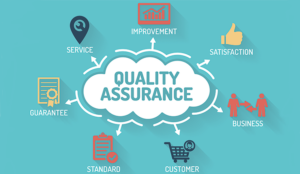Shilpi Gupta at Cyara asks if your call centre has a plan for quality assurance.
CX Defects and Failures Present Real Risks To Your Business
In call centre customer service, quality isn’t always a given. In fact, it can be downright elusive. Just ask anyone who’s had to call their utility company or cellphone provider recently.
But that doesn’t mean it’s unattainable. And, not only can contact centres achieve quality service; they must. As more customers rely on interacting with companies through various digital channels, those companies must deliver better service and mitigate risks if they want to remain competitive.
That’s not an easy task, though. Business needs and customer expectations are always in flux, and the underlying technology you need to assure quality is complex. To mitigate risks and deliver higher quality service, call centres must commit to a robust quality assurance (QA) strategy.
The Risks of Going Without a QA Strategy
A carefully planned QA strategy is expensive. It takes a significant investment in upgrading outdated technologies and revamping the way you do business. Yet, it’s considerably less expensive than living with a half-baked CX.
That’s because customer experience that doesn’t deliver consistently high-quality carries many hidden costs. Consider what just a few CX defects and failures can cost your business.
Poor Call Quality
We’ve all experienced the frustration of a call with poor voice quality. Few things are more frustrating than waiting on hold for 30 minutes only to have your call breaking up when you finally talk to an agent.
Whether you can’t understand their questions or they need to you repeat your explanations, it’s not a recipe for a great customer experience.
Last year, we even examined the relationship between poor call quality and average hold times. Based on research from McIntosh and Associates, which showed a 27% increase in average handle time (AHT) for calls due to poor voice quality, we calculated how poor quality could easily cost a large contact centre $6 million per year in labor alone.
Subpar Customer Experience
Of course, the true costs of poor call quality are much more far-reaching, and voice quality is only one aspect of customer experience. If your call centre has poor voice quality, it may have many other CX issues.
Here are a few of the most common sources of customer frustration stemming from contact centre problems:
- 66% of customers get irritated when they have to repeat themselves.
- 67% of customers have hung up out of frustration when they couldn’t connect with a live customer.
- Almost 60% of customers report that long hold times are the most frustrating aspect of a poor call centre experience.
- 32% of customers said they’d stop doing business with a brand they loved after one bad experience.
- Considering a different channel, 46% of customers don’t like dealing with chatbots because they don’t find they can handle complex questions.
These customer frustrations aren’t stagnant, either. They lead to action — whether it’s leaving for a competitor or shouting their frustrations for all the world to see on social media.
The consequences can be immediate for your bottom line, but the ripple effect of poor NPS scores and a bad reputation can be much more devastating.
Service Outages
At the extreme end of CX defects is the dreaded SEV1 outage. Here, the software problems pile up to the point where everything grinds to a halt. Whether it’s a few minutes or a few hours, the costs can be tremendous. One Forrester study of Cyara customers estimated that one hour of downtime costs our average customer $100,000.
Again, that $100,000-per-hour hit doesn’t even account for the many frustrated customers who couldn’t get through to have their issues addressed.
A Snowball Effect
As you can see, the costs of poor CX can snowball, revealing just how serious a risk it poses to call centres. When quality isn’t a top priority, it’s difficult to quantify the long-term impact on your business. Unhappy customers, abandoned calls, full-blown outages — these issues and more drain your bottom line.
What’s Your Plan for Mitigating These Risks?
These risks to your call centre are real, but you can address them with a comprehensive plan for quality assurance. So, what does this look like?
1. Achieve CX Assurance Through Testing and Monitoring
Quality assurance begins and ends with continuous, automated testing and monitoring. The only way to root out defects is to test at every stage of the software development lifecycle and consistently monitor the live CX environment for your call centre.
Implementing continuous testing has helped countless customers mitigate these risks and minimize the costs of defects. For instance, another Forrester economic impact study showed that our typical customer saved $2.2 million in reduced downtime and $441,000 in recaptured abandoned callers over three years.
2. Design for Self-Service
In many cases, improving customer service doesn’t mean enhancing every channel for human-to-human interaction. Many customers aren’t even interested in talking to a human.
As one PwC study showed, most consumers put speed and convenience at the top of their list for customer service. Often, they simply want the system to help them solve their own problem.
One particular advantage of today’s AI-powered CX technology is that much of it can be designed for self-service. Chatbots and automated IVRs can provide answers to many common questions on their own. When more of your customers can handle their issues without an agent, it saves you money and increases their satisfaction.
3. Build an Omnichannel Experience
In this new age of digital customer service, customers are increasingly comfortable moving across channels for support. Rather than wait on hold for an hour, they’re happy to start their service experience via chat, shift it to email, and end it on the phone.
Providing your customers with that ability, however, involves building a robust, interconnected web of CX channels. If you try to do this halfheartedly, it can backfire. As one study by Deloitte showed, 87% of customers expressed frustration about moving across channels, only to find they had to repeat everything they’d already said.
When customers can move fluidly through your web of service options — without repeating themselves or starting over — you have a true omnichannel experience that can surprise and delight them.
Building a complete plan for QA in your call centre is a big job, but it’s essential if you want to mitigate the many risks of defects and failures in your CX. Don’t worry, though — you’re not alone in the task.
Author: Guest Author
Published On: 23rd Jun 2022
Read more about - Guest Blogs, Cyara



































